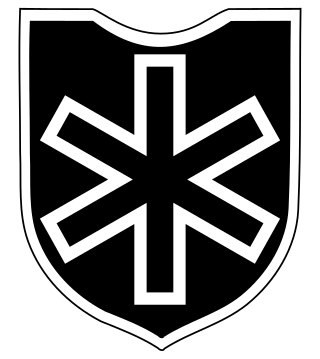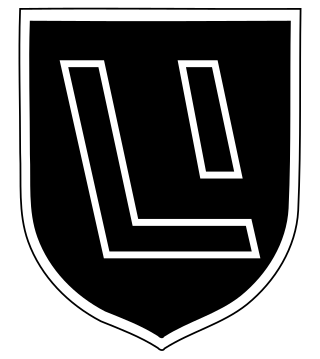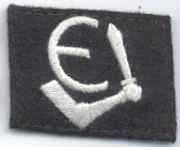
The Waffen-SS was the combat branch of the Nazi Party's paramilitary Schutzstaffel (SS) organisation. Its formations included men from Nazi Germany, along with volunteers and conscripts from both occupied and unoccupied lands.

The Waffen Grenadier Brigade of the SS Charlemagne was a Waffen-SS unit formed in September 1944 from French collaborationists, many of whom were already serving in various other German units.

The 6th SS Mountain Division "Nord" was a German unit of the Waffen-SS during World War II, formed in February 1941 as SS Kampfgruppe Nord.

The 11th SS Volunteer Panzergrenadier Division Nordland was a Waffen-SS division primarily raised with Germans and ethnic Germans from Romania, but also foreign volunteers from Northern and Western Europe. It saw action, as part of Army Group North, in the Independent State of Croatia and on the Eastern Front during World War II.

The Dirlewanger Brigade, also known as the SS-Sturmbrigade Dirlewanger (1944), or the 36th Waffen Grenadier Division of the SS, or The Black Hunters, was a unit of the Waffen-SS during World War II. The unit, named after its commander Oskar Dirlewanger, consisted of convicted criminals who were not expected to survive their service with the unit. Originally formed from convicted poachers in 1940 and first deployed for counter-insurgency duties against the Polish resistance movement, the brigade saw service in anti-partisan actions in German-occupied Eastern Europe.
The III (Germanic) SS Panzer Corps was a Waffen-SS armoured corps which saw action on the Eastern Front during World War II. The (Germanische) part of its designation was granted as it was composed primarily of foreign volunteer formations.

The Battle of Narva Bridgehead was the campaign that stalled the Soviet Estonian operation in the surroundings of the town of Narva for six months. It was the first phase of the Battle of Narva campaign fought at the Eastern Front during World War II, the second phase being the Battle of Tannenberg Line.

The Battle of Tannenberg Line or the Battle of the Blue Hills was a military engagement between the German Army Detachment Narwa and the Soviet Leningrad Front. They fought for the strategically important Narva Isthmus from 25 July–10 August 1944. The battle was fought on the Eastern Front during World War II. The strategic aim of the Soviet Estonian Operation was to reoccupy Estonia as a favorable base for the invasions of Finland and East Prussia. Waffen-SS forces included 24 volunteer infantry battalions from the SS Division Nordland, the SS Division Langemarck, the SS Division Nederland, and the Walloon Legion. Roughly half of the infantry consisted of the personnel of the 20th Waffen Grenadier Division of the SS. The German force of 22,250 men held off 136,830 Soviet troops. As the Soviet forces were constantly reinforced, their overall casualties are estimated by Estonian historian Mart Laar to be 170,000 dead and wounded.

The Volunteer Legion Netherlands was a collaborationist military formation recruited in the German-occupied Netherlands during World War II. It was formed in the aftermath of the German invasion of the Soviet Union and fought on the Eastern Front in the Waffen SS alongside similar formations from other parts of German-occupied Western Europe. It was the largest Dutch SS unit.
The 20th Waffen Grenadier Division of the SS was a foreign infantry division of the Waffen-SS that served alongside but was never formally part of the Wehrmacht during World War II. According to some sources, the division was under Reichsführer-SS Heinrich Himmler's overall command but was not an integral part of the Schutzstaffel (SS). It was officially activated on 24 January 1944, and many of its soldiers had been members of the Estonian Legion and/or the 3rd Estonian SS Volunteer Brigade, which had been fighting as part of German forces since August 1942 and October 1943 respectively. Both of the preceding formations drew their personnel from German-occupied Estonia. Shortly after its official activation, widespread conscription within Estonia was announced by the German occupying authorities. The division was formed in Estonia around a cadre comprising the 3rd Estonian SS Volunteer Brigade, and was initially known as the 20th Estonian SS Volunteer Division.

The 30th Waffen Grenadier Division of the SS(1st Belarusian), originally called the 30th Waffen Grenadier Division of the SS , was a short-lived German Waffen-SS infantry division formed largely from Belarusian, Russian, Polish, and Ukrainian personnel of the Schutzmannschaft-Brigade Siegling in August 1944 at Warsaw in the General Government.

The 15th Waffen Grenadier Division of the SS , originally called the Latvian SS-Volunteer Division was an infantry division of the Waffen-SS during World War II. It was formed in February 1943, and together with its sister unit, the 19th Waffen Grenadier Division of the SS formed the Latvian Legion.

The 29th Waffen Grenadier Division of the SS also Legione SS Italiana was an SS formation of Nazi Germany during World War II. It was originally created in the puppet Italian Social Republic in 1943 as the Italian Legion, later renamed to a brigade. The unit was upgraded to division status on 10 February 1945.

The Führer Grenadier Brigade was an élite German Army combat unit which saw action during World War II. The Führer Grenadier Brigade is sometimes mistakenly perceived as being a part of the Waffen-SS, whereas it was actually an Army unit and technically assigned to the Großdeutschland Division. This misconception comes from its original duty of guarding Adolf Hitler's East Prussian Wolfsschanze Headquarters, a task which sounded similar to the original one of Waffen-SS 1. Panzer Division "Leibstandarte SS Adolf Hitler", which in turn stemmed from the Führer's original bodyguard corps. Fighting on both the Eastern and Western Fronts, the brigade surrendered to U.S. forces in Austria in 1945.

Harald Nugiseks was an Waffen-Oberscharführer (Sergeant) in World War II, who served in the 20th Waffen Grenadier Division of the SS of the Waffen-SS. Nugiseks is also one of the four Estonian soldiers who received the Knight's Cross of the Iron Cross.
Martin Kohlroser was a mid-ranking commander in the Waffen SS during World War II who was awarded the German Cross in Gold.
The 2nd SS Infantry Brigade (mot.) was formed on the 15 May 1941, under the command of Karl Fischer von Treuenfeld with the 4th and 5th SS Infantry Regiments and began its operational service in September in the Army Group North Rear Area, under which command it would spend its entire existence. It gradually began to incorporate foreign legions of the SS under its operational control. After the western legions departed for refit, it began operating with Latvian volunteer formations and eventually was redesignated the 2nd Latvian SS Infantry Brigade and on the 18 May 1943, and used as the cadre in the formation of the Waffen Grenadier Division of the SS in January 1944.

The 3rd Estonian SS Volunteer Brigade was a formation of the German Waffen-SS during World War II. It was formed in May 1943, when the Estonian SS Legion was upgraded. The first name chosen for the brigade was the Estonian SS Volunteer Brigade, until October 1943, when all SS brigades were numbered so it finally became the 3rd Estonian Volunteer Brigade. The brigade was expanded to a division and renamed on January 23, 1944.

During World War II, the Waffen-SS recruited significant numbers of non-Germans, both as volunteers and conscripts. In total some 500,000 non-Germans and ethnic Germans from outside Germany, mostly from German-occupied Europe, were recruited between 1940 and 1945. The units were under the control of the SS Führungshauptamt beneath Reichsführer-SS Heinrich Himmler. Upon mobilisation, the units' tactical control was given to the Oberkommando der Wehrmacht.















